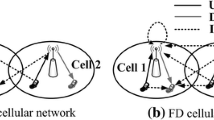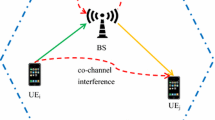Abstract
In recent years, Full Duplex cellular systems are under investigation. Previous works found that in full duplex systems, rate does not double because of not only self interference but also due to full duplex BSs interference. In this paper, a Hybrid duplex (H) two tier Heterogeneous Cellular Network is considered: Small pico Base Stations (BSs) use full duplex mode while macro BSs run usual Half Duplex transmission to avoid high interference. Different duplexing modes and association criteria are analyzed and their performance compared in terms of coverage, binary rate and Energy Efficiency. The simulation results show that hybrid mode rate and energy efficiency are the highest compared to full or half duplex modes while coverage does not reduce much. From association criteria point of view, binary rate and energy efficiency are better under maximum receive power in average association criteria whereas coverage is better in minimum path loss association criteria.











Similar content being viewed by others
References
Bliss, D. W., Parker, P. A., & Margetts, A. R. (2007). simultaneous transmission and reception for improved wireless network performance. In Proceedings of IEEE 14th workshop on statistical signal processing, Madison, WI.
Bozidar, R., Gunawardena, D., Peter, K., Alexandre, P., Nikhil, S., Horia, V. B., & Gerald, D. (2010). Rethinking indoor wireless mesh design: low power, low frequency, full-duplex. In Fifth IEEE workshop on wireless mesh networks (WIMESH 2010), Boston, USA.
Bharadia, D., McMilin, E., & Katti, S. (2013). Full Duplex Radios (p. 375386). Hong Kong: In Proceedings of ACM SIGCOMM.
3GPP, TR 36.216. (2010). Technical Specification Group Radio Access Network; Evolved Universal Terrestrial Radio Access (E-UTRA); Physical layer for relaying operation (Release 10). http://www.3gpp.org.
Goyal, S., Pei, L., Hua, S., & Shivendra, P. (2013). Analyzing a full-duplex cellular system. In Proceedings of conference on information sciences and systems (CISS), Baltimore, MD, USA.
Goyal, S., Pei, L., Shivendra, P., Robert A. D., Rui, Y., Jialing, L., & Erdem B. (2014). Improving small cell capacity with common-carrier full duplex radios. In IEEE international conference on communications (ICC), Sydney, NSW, Australia.
Goyal, S., Pei, L., Shivendra, P., Robert, A. D., Rui, Y., & Erdem, B. (2015). Full duplex cellular systems: will doubling interference prevent doubling capacity? IEEE Communications Magazine, 53(5), 121–127.
Achaleshwar S., Suhas, D., & Ashutosh, S. (2013). On uplink/downlink full-duplex networks. In Asilomar conference on signals, systems and computers, Pacific Grove, CA, USA.
Goyal, S., Galiotto, C., Marchetti, N., & Panwar, S. (2016). Throughput and coverage for a mixed full and half duplex small cell network. In IEEE international conference on communications (ICC), Kuala Lumpur, Malaysia.
Li, R., Chen, Y., Ye Li, G., & Liu, G. (2017). Full-duplex cellular networks. IEEE Communications Magazine, 55(4), 184–191.
Omar, M. A., Y, Deng, Aijaz, A., & Nallanathan, A. (2017). Full-duplex small cells for next generation heterogeneous cellular networks: A case study of outage and rate coverage analysis. IEEE Access, 5, 8025–8038.
3GPP TR 36.828 V11.0.0 (2012). Technical Specification Group Radio Access Network; Evolved Universal Terrestrial Radio Access (E-UTRA); Further enhancements to LTE Time Division Duplex (TDD) for Downlink-Uplink (DL-UL) interference management and traffic adaptation (Release 11).
Mujtaba, M. S., & Aguayo-Torres, M. C. (2017). Fairness and rate coverage of symmetric transmission over heterogeneous cellular networks under diverse coupling and association criteria. Wireless Personal Communications Journal. https://doi.org/10.1007/s11277-017-4418-6.
Acknowledgements
This work has been partially supported by the Spanish Government under the project TEC2013-44442-P.
Author information
Authors and Affiliations
Corresponding author
Additional information
Publisher's Note
Springer Nature remains neutral with regard to jurisdictional claims in published maps and institutional affiliations.
Rights and permissions
About this article
Cite this article
Shaikh, M.M., Aguayo-Torres, M.C. Analysis of Coverage and Binary Rate in a Hybrid/Full Duplex Heterogeneous Cellular Network under Various Association Criteria. Wireless Pers Commun 106, 2211–2224 (2019). https://doi.org/10.1007/s11277-018-5935-7
Published:
Issue Date:
DOI: https://doi.org/10.1007/s11277-018-5935-7




